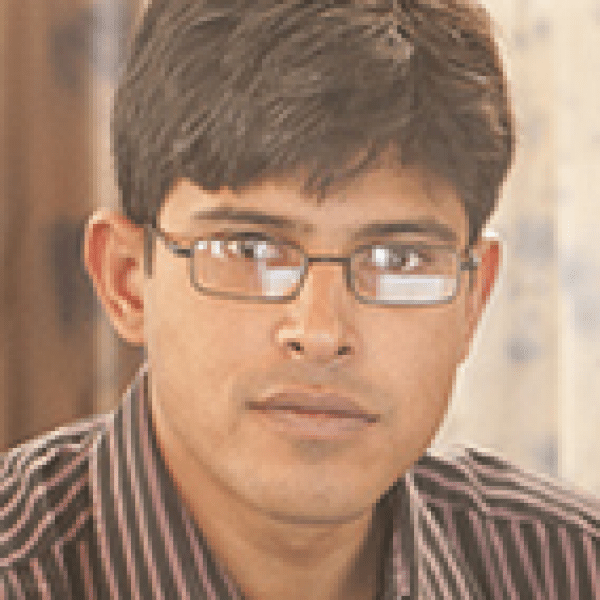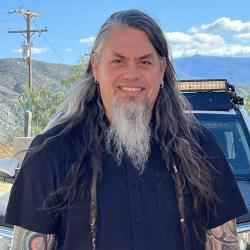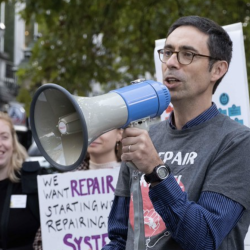Introduction
Arjun is transforming communities in remote conflict areas from passive witnesses to proactive voices and forces that respond to the issues they are faced with, in their contexts. He is creating a safe channel for such communities to not only share issues among themselves and the external world but also to receive guidance on tangible solutions to their problems, to take action, and to report on the results.
The New Idea
Arjun Venkatraman is building platforms that democratize access to media and information in remote conflict areas while empowering communities to respond to their own problems. To give ‘voices’ to communities in areas with limited to no access to news and media, Arjun has helped scale a simple mobile phone-based voice interface that allows communities to share information and reports, within the community and on larger media platforms. However, Arjun recognizes that broadcasting alone will not do justice to the voices and that it will likely not be sufficient to motivate communities to engage, take action and create change. To close the loop on grievance reports or human rights violations, Arjun has built a powerful community of freelance volunteer professionals from across India – including lawyers, doctors, conservationists, journalists and students who bring in their skills and knowledge to work closely with communities to shape solutions to problems they are reporting. Arjun is creating an action system that empowers both the rural as well as urban professional individuals to participate in bringing about positive change on the ground.
Arjun spreads the installation of the mobile voice response system and trains CSOs and local village governments who work in remote villages to use, run and moderate content reported by the communities. The content is then pushed on to community of 50 moderators who link the reports to audiences who are prepared to take action on them.
The Problem
In the recent past, there has been a lot of effort to increase access to information to rural marginalised communities. However, the system to include the voices of the poor and marginalised communities in mainstream media is still missing. A study published in 2011 by the Economic and Political Weekly stated that in their total coverage, India’s highest circulated English and Hindi dailies include only 2% news from rural India. This is largely because mainstream media houses do not have the resources (reporters or funds) to access and diseminate news and media in rural parts of india. They are unable to have bases in or travel to gather gather news stories in rural areas of such a large and diversity country.
In a study called “Voices of the Poor” in 2002, the World Bank surveyed 20,000 people living under the poverty line, and concluded that the single greatest hurdle to their advancement was not food, shelter or education, but the lack of a platform to exchange local news, opinions, report grievances, and share this information within their own community and the world at large. The study revealed how rural populations are unable to discuss issues that affect them. This limits their ability to recognise that other communities are sharing similar problems, and to collaborate with them to co-create solutions. Without the capacity to voice their needs to the larger world and to political authorities rural communities become excluded from active participation in designing their own future development.
In the past few years, there have been efforts to set up systems for rural communities to share information through community radios or other platforms. However, these platforms do not work as effectively in conflict zones since people do not have the power to openly share their views and reports. Further, disenfranchised over generations, these communities lack the knowledge and skills to respond to their own situations. As a result, not only do grave injustices continue, comunities also slowly lose motivation to continue sharing the stories. There is an urgent need to establish a system that enables communities to build trust in the power of media.
Arjun has identified the absence of a response system as a key missing element in establishing trust and building the effectiveness of community voice. He addresses this gap by enabling action on violations reported or opening up avenues to solve local problems.
The Strategy
The ‘Swara’ (voice) platform, that was launched when Arjun joined the team, allows rural communities to report information, news and grievances through their mobile phones. High call volumes during the pilot phase convinced Arjun that Swara was meeting a need for communities to voice their issues. They register their information through a simple “missed call” system, where any member from the community can call the Swara phone number and disconnect before the system receives the call. The Swara network calls them back, and they then press 1 to record content, or 2 to listen to content other community members have uploaded they can record their report. This leads to a low to no cost model where anyone can report without any expense. The automated system emails these raw voice recordings to a community of 50 moderators that Arjun built, comprising community leaders, NGO workers of the community and Swara employees, who clean up the recording, accompany it with a transcription, translation into English and call to action.
However, the mere generation of news stories by the community was not enough of a social impact for Arjun. Arjun questioned what the social impact of the stories were, and what was being done to address the human rights violations these community news reports brought to attention. TO address this Arjun built a community of around 300 freelance professionals, known as the Hackergram community, who have volunteered to take action on the grievances being reported from the rural communities. The moderator community emails the content to Hackergram members, and also publishes the content on social media platfroms and mainstream media, opening up the process for anyone and everyone to be able to take action on the reported grassroots problems. Swara has an understanding with the communities who initiate the reports that they will in turn report responses and solutions. When the community members that reported the problem call back and report that it has been solved, Arjun considers this an impact report.
Alongside pushing this content to mainstream media channels and networks, Arjun started exploring ways to scale ‘Swara’ in more communities. To achieve this, Arjun realized that it was important to reduce the cost of technology significantly. He used his engineering and technical skills to set up the Mojolab Foundation (Demystifying Technology) in 2010. Mojolab is a technical resource to research, develop, deploy and maintain low cost, sustainable technological tools and platforms for communities to use. Arjun’s team at Mojo Lab was able to reduce the cost of setting up the Swara (Voice) Interactive Voice Response system from US$2000, to US$200, make the hardware much smaller so it needed less space to set-up and became more portable. This allowed Arjun to rapidly scale to ten states of India- the tribal states of Madhya Pradesh, Andhra Pradesh, Odisha, the conflict ridden states of Jharkhand and Bihar where the common people are victimised in the conflict between armed rebellion guerrilla groups and the state armed forces, Rajasthan, Gujarat, Southern Uttar Pradesh and West Bengal.
Today, Mojolab Foundation continues to innovate by implementing the use of low-cost platforms to allow rural communities to upload content via various media. For example, they are setting up audio-enabled web portals (audio portals) that allow users who cannot read to connect to the internet. It is also designing a low cost citizen band radio antenna and receiver to enable communities to broadcast information and several software-based productivity tools for community-based content and data management.
The Swara network is organised and customized for geographical or thematic functional communities. For example, the Swara network targetted at resolving legal issues and public greivances is called NyayaSwara (Legal Voices) . In the Himalayan region, Swara is known as Himalaya Swara, and is currently being used to track migrant workers between Nepal and India, particularly those feared missing in the recent natural disaster in the region. In Chhatisgarh and other parts of Central India, on the other hand, the Swara network is called CGNetSwara ( CGNet stands for Central Gondwana Network, refering to the pre-historic landmass that eventually formed this part of the world) as it encompasses all state issues. Another member of the Swara Network is Swasthya Swara, a platform that brings together traditional healers from the forests of India to share their knowledge of herbal remedies in audio format for documentation and use by others. These flexible organisational structures enable the moderators Arjun has assembled to content to the right media partners, and build a community of specific professionals around each of the Swara networks. For example, Arjun knows to direct content from NyayaSwara to legal and human rights forums, and build a community of lawyers to take action on the violation reports that come in through the platform. This specificity is more effective than directing news to a larger generic audience and diffusing its effect.
Seeing the critical need to enable action on issues reported, Arjun is simultaneously bringing together freelance professionals and entrepreneurs, such as lawyers, doctors, conservationists, journalists and students as “Hackergram” community (equivalent, in Hindi, to “I am because I do” Village) to support communities to respond to their situations. Hackergram members follow up on actionable reports using expertise from their respective professions, to help provide a real world response where possible. For example, if a Swara user from a rural community uploads a news report that states the police torched their village, a lawyer who’s part of the Hackergram community will file a Right to Information Act to discover why the village was torched, who was to blame, file a complaint with legal authorities, to get the villagers compensation and punish the assailants. . The sustainability of this approach is not in that the same people who are at Hackergram now will stay, but that Hackergram will continue to attract members who will take the idea forward. Today, 24,000 unique individuals use Arjun’s system. The platform has received 300,000 information reports and been instrumental in producing 2700 impact reports.
The Hackergram professionals are now in the process of training and equipping Swara users with the skills and tools they need to take action on their own problems. For example, Swara users have been trained how to file a police complaint and navigate the legal system, transfer knowledge of natural medicine, and so on. Arjun’s vision is to democratise the knowledge that currently only the Hackergram professionals have, so that rural communities have access to this knowledge to be able to work together to solve their own problems. That way members of the community would be utilizing their knowledge to solve community problems, and so that one day Hackergram can work itself out of its job.
The Person
Arjun is a third generation entrepreneur. He sees his life shaped by three entrepreneurial experiences. His grandfather founded a tribal development non-profit. Growing up, Arjun saw the personal challenges of running a non-profit, the financial challenges the family faced, and the conflicts within the family due to his grandfather’s unconventional choice of work.
When Arjun was a teenager, his parents started a mushroom farm with a government subsidiary grant. Watching his parents struggle with establishing a business, Arjun learnt the skills of registering and running an enterprise, building a market, distribution, partnerships, and so on.
After graduating with a degree in engineering, Arjun, unsurprisingly, went on to join technology start-upAtlantis Computing, focusing on enterprisedata storage. Arjun helped take Atlantis from a small start-up in India to a million dollar company in Silicon Valley. Arjun looks back at his period establishing Atlantis as the period where he learnt the skills to articulate and pitch his work, hire a team and do fundraising.
While Arjun was in California, his step-father, Shubhranshu started a non-profit in India, CGNetSwara, that worked to get people from rural communities in the tribal state of Chhatisgarh to report news from the grassroots, and sent this out to a mailing list of social activists. Arjun had the opportunity to observe Shubhranshu moderating the platform and heard much of the content that was being reported by the rural communities. Arjun started feeling an increasing sense of frustration listening to these reported cases of human rights violations, and not being able to take any action on it. He felt that it was not enough to bring these grievances into mainstream news, and decided to move back to India, to not only scale CGNetSwara to other communities, but to build a system that would take action on the violations being reported from the rural communities. After spending time with local citizens’ groups from many areas of India, Nepal,Afghanistan, Indonesia, Cambodia and Myanmar he sees that there is more than enough work for his lifetime to bring isolated or conflict-ridden communities into a human communications network that uses technology cheaply and consciously to create social value.




